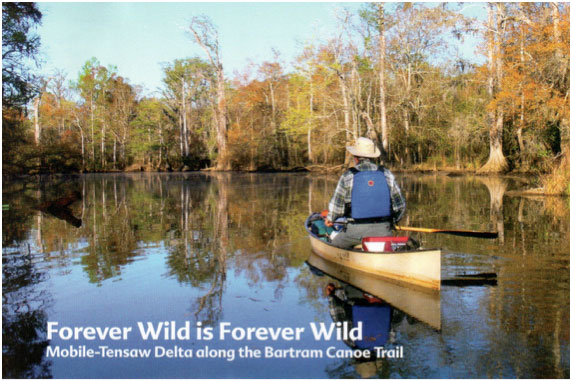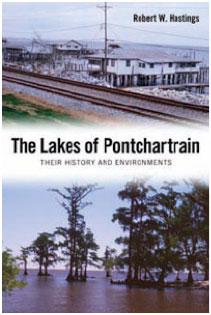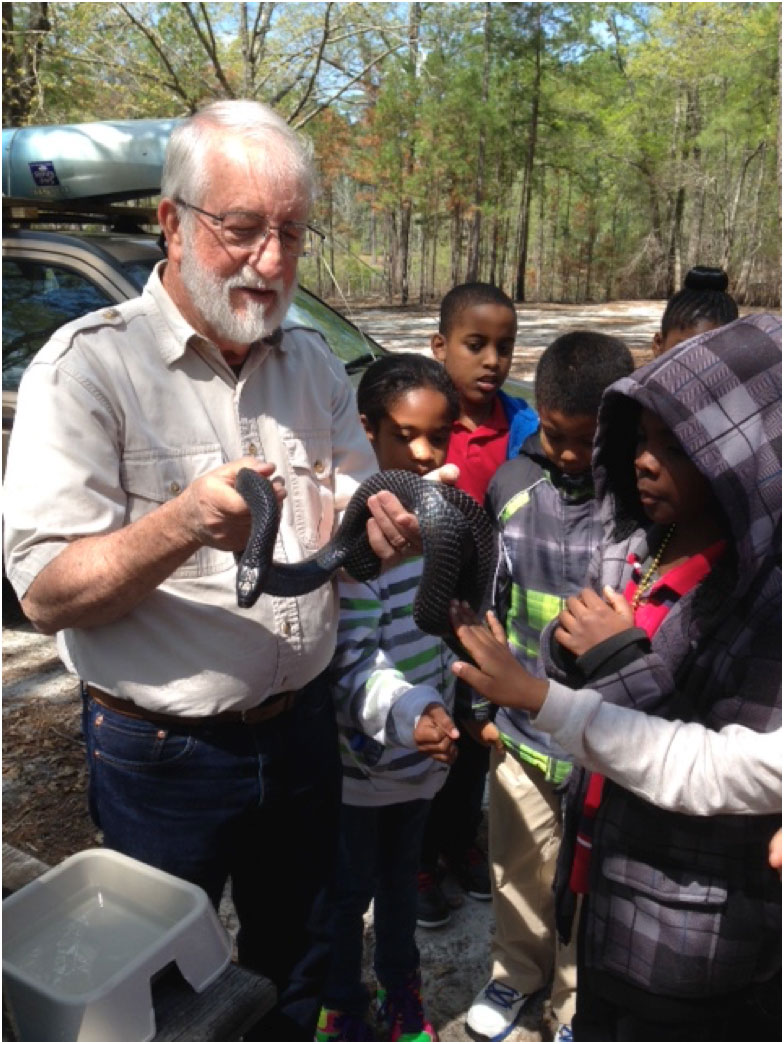
Alabama's own Bob Hastings was recently given a special service award for his long-time work with Sierra Club and his passion for our natural environment. Below, you will find the information that was originally sent in with his nomination.
New Jersey – 1982-1984
Robert W. (Bob) Hastings first joined the Sierra Club in 1982, while living in New Jersey. Since he moved from New Jersey to Louisiana in 1984, he was only briefly involved with the New Jersey Chapter, but did lobby with Sierra Club members for protection of threatened and endangered species, and for establishment of the Pinelands Preserve. In November, 1983, he was deposed as an expert witness for a Sierra Club suit for protection of endangered snakes in the Pinelands (Attachment 4). As a zoologist at Rutgers University for 12 years, he was actively involved with various environmental issues, and authored several publications based upon his research on New Jersey vertebrates. In fact, throughout his 30-year career as a university professor, with expertise in vertebrate zoology, marine biology, and wetlands ecology, he was thoroughly committed to environmental protection, and his service to the Sierra Club and numerous other environmental organizations continuously merged with his professional responsibilities. As an environmentalist with scientific expertise on these subject areas, he was frequently asked to give talks to school groups and civic organizations, as well as to Sierra Club and other environmental organizations. Since he had a special interest in the biology of reptiles, his presentations including live snakes became especially popular. He was also frequently interviewed on environmental issues for newspaper articles and radio and television news programs.
Louisiana – 1984-2001
 Shortly after moving to Louisiana to become Director of the Turtle Cove Environmental Research Station on Lake Pontchartrain, and a faculty member at Southeastern Louisiana University, Bob attended his first Sierra Club meeting (in September, 1984) to begin a long association with the Delta Chapter, and the Chappapeela-Honey Island Group. He was to serve as an Executive Committee member and in other leadership positions of both Group and Chapter, and would host numerous Sierra Club meetings at Turtle Cove. He served on the Honey Island Group Executive Committee from 1993 to 2001, and was elected Chair in 2000. He also served on the Delta Chapter Executive Committee from 1993 to 2001, as Vice-Chair in 1993, 1996-98, and 2000, and as Chair in 1994 and 1995. After becoming Chair of the Delta Chapter in 1994, he went to San Francisco for Chapter Leadership Training. He also served as a representative to the Sierra Club’s Gulf Coast Regional Conservation Committee (GCRCC). One of his most memorable meetings was in Columbia, Mississippi, in June, 1994, when GCRCC met with a local group called “Jesus’s People Against Pollution” (or JPAP), a local grassroots organization formed in response to environmental contamination from an abandoned industrial site. This experience sparked his continuing dedication to the principles of environmental justice.
Shortly after moving to Louisiana to become Director of the Turtle Cove Environmental Research Station on Lake Pontchartrain, and a faculty member at Southeastern Louisiana University, Bob attended his first Sierra Club meeting (in September, 1984) to begin a long association with the Delta Chapter, and the Chappapeela-Honey Island Group. He was to serve as an Executive Committee member and in other leadership positions of both Group and Chapter, and would host numerous Sierra Club meetings at Turtle Cove. He served on the Honey Island Group Executive Committee from 1993 to 2001, and was elected Chair in 2000. He also served on the Delta Chapter Executive Committee from 1993 to 2001, as Vice-Chair in 1993, 1996-98, and 2000, and as Chair in 1994 and 1995. After becoming Chair of the Delta Chapter in 1994, he went to San Francisco for Chapter Leadership Training. He also served as a representative to the Sierra Club’s Gulf Coast Regional Conservation Committee (GCRCC). One of his most memorable meetings was in Columbia, Mississippi, in June, 1994, when GCRCC met with a local group called “Jesus’s People Against Pollution” (or JPAP), a local grassroots organization formed in response to environmental contamination from an abandoned industrial site. This experience sparked his continuing dedication to the principles of environmental justice.
Bob participated in another significant GCRCC meeting in December, 1994, at Coffeen Nature Preserve at Four-Mile Village in Santa Rosa Beach, Florida. This meeting also included members of the Sierra Club Marine Committee and the Sierra Club Legal Defense Fund, who met to discuss the formation of a new organization to address environmental problems of the Gulf of Mexico. The resulting organization was the Gulf Restoration Network (or GRN). Bob was to become a Board member for GRN in 1998 (continuing up until the present), and served as Board Chair in 2007-2012).
A major campaign of the Delta Chapter at this time was the restoration of Lake Pontchartrain water quality. Bob’s research on Lake Pontchartrain and surrounding areas merged with the Sierra Club campaign, and he frequently gave talks on this research at Sierra Club meetings. He also became active in several other environmental organizations during this period, including the Lake Pontchartrain Task Force and Lake Pontchartrain Basin Foundation, for which he served on the Technical Advisory Committee and Environmental Education Committee. Eventually he was to publish a book based upon his research, “The Lakes of Pontchartrain: Their History and Environments” (University Press of Mississippi, 2009).
With Bob’s position as Director of the Turtle Cove research facility (and the presence of overnight accommodations), Turtle Cove became a popular meeting site for many organizations, including Sierra Club Chapter and GCRCC meetings and outings. Bob also became a volunteer with the New Orleans Sierra Club Inner City Outings program, and hosted more than 20 ICO overnight outings to Turtle Cove between 1993 and 2000 (Figure 1). Children from the Gerttown Community Center and the Pediatric AIDS Program who came to Turtle Cove on ICO outings were able to fish, swim, and canoe, as well as play environmental games. Initially, many were quite fearful of the “wild” swamp environment, but soon became comfortable with these new surroundings, and enjoyed their experiences at Turtle Cove. Bob and his family also hosted several ICO groups at their home for swimming and cookouts, and in July, 1997, went along on a weeklong ICO trip to Big South Fork National River and Recreation Area in Tennessee.

Bob with ICO children and another volunteer (1996); B. Letter from Ariana (text enlarged above).
A favorite paddling and swimming river for Sierra Club outings in southeast Louisiana was the Tangipahoa River, but in the 1980s it was posted as unsafe for swimming. To address pollution problems in the river, Bob and other Sierra Club members helped to form a new grassroots organization in 1988, Citizens for a Clean Tangipahoa or CFACT, and Bob served as president in 1993-94. In August, 1991, Bob led a canoeing/camping trip down the entire length of the river to draw attention to the pollution problems. He prepared a CFACT Slide Show on Water Quality Problems and Solutions in the Tangipahoa River and presented it to numerous school and civic groups between 1991 and 2000. In April, 1998, he helped organize and chaired a Sierra Club Chapter seminar on pollution in Southeast Louisiana rivers. The effectiveness of CFACT’s campaign resulted in the posted signs being removed in 2002, and success finally came in 2009, when the river was declared clean.
Throughout this period Bob was continuing to give frequent talks on environmental issues, Turtle Cove research projects, and snakes for various schools and other groups. In addition, there were numerous letters to the editor, letters to political leaders, and media interviews on environmental issues.
Because of his dedication to environmental education and programs developed at Turtle Cove, Bob was given numerous awards in recognition of this service. These included Conservation Educator of the Year (1993) - Governor's Conservation Achievement Award presented by Louisiana Wildlife Federation, February, 1994; Conservation Award (1995) ‑ presented by National Society Daughters of the American Revolution; Coastal Stewardship Award for Education (1997) - presented by Coalition to Restore Coastal Louisiana; Award for Excellence in Environmental Education (1998) – presented by U.S. Environmental Protection Agency Region 6; President’s Award for Excellence in Faculty Service, May, 2000 – presented by Southeastern Louisiana University; and National Wetlands Award in Education/Outreach, May, 2002 (sponsored by the Environmental Law Institute, U. S. Environmental Protection Agency, U. S. Natural Resources Conservation Service, U. S. Forest Service, and National Marine Fisheries Service).
Alabama – 2002-2015
Bob resigned from Southeastern Louisiana University in 2001 and moved to Alabama in January, 2002, to become Director of the Alabama Natural Heritage Program, working to protect threatened and endangered species. He again became active in the Sierra Club, in both the Montgomery Group and the Alabama Chapter, and continued his commitment to environmental protection. He was elected to the Alabama Chapter Executive Committee in 2003, has continued to serve up until the present, and now serves as Chair (in 2014-2015). He has served in numerous other positions within the Chapter, including Vice-Chair (2006-2013), Council of Club Leaders Delegate (2007-2012), Conservation Chair (2007-2013), Environmental Justice Chair (2007-2015), and HELEN Site Administrator (2008-2015). In the latter position as well as in prior years, he has taken the lead in submitting annual updates to Chapter Leader Lists. Bob also organized the 2014 Chapter Annual Retreat.
Bob participated in National Sierra Club Conservation Leader Training in August, 2010, via conference call. Then in 2011, Bob and other members of the Chapter participated in Chapter Leader Training, a series of six monthly conference call sessions between January and May.
In January, 2013, Bob and other Chapter leaders helped organize a Chapter-National Joint Planning Workshop, with participation from National Board member Robin Mann, staff member Greg Casini, and committee volunteer Ann Rizzo. This two-day planning workshop resulted in the development of the Chapter’s Water Campaign. In cooperation with the Alabama Rivers Alliance, Bob and other Chapter leaders helped to organize and sponsor a series of conferences throughout the state in 2013 and 2014 to publicize the need for a comprehensive Water Management Plan for Alabama, and to guide the development of that plan to protect the state’s natural waters. Bob has also been nominated to serve on the focus panels to evaluate the various aspects of the proposed plan.
Other recent Alabama Chapter campaigns, have included protests of fracking on public lands, and in September, 2013, Bob and Chapter Chair Margo Rebar attended the Tennessee Chapter Anti-Fracking Conference in Knoxville.
Alabama’s program to preserve natural lands for public use, the Forever Wild program, was slated to expire in 2012, after 20 years of success. Consequently, the Sierra Club and other environmental organizations mounted a campaign to encourage voters to approve a constitutional amendment to renew Forever Wild for another 20 years. The campaign was successful and the vote was strongly in favor of renewing the program.
The Alabama Chapter has also been active in helping to protect existing State public lands. Perry Lakes Park near Marion has been a popular site for Sierra Club outings, but was threatened several years ago by a proposal to log the area. The Sierra Club joined with other groups to oppose this logging. More recently, state parks have been threatened with increased “development”, and even closure as a means of addressing long-term budgetary crises within the state. One plan opposed by the Sierra Club is to use Natural Resources Damage Assessment funds resulting from the BP oil spill disaster to build a convention center on the beach at Gulf State Park. Bob and other Sierra Club members have protested such misuse of NRDA funds, and with encouragement from Bob, the Gulf Restoration Network has filed a legal suit opposing the planned construction. This year the Alabama governor has threatened to close 15 of the state’s 22 parks if additional taxes are not approved by the legislature. Many citizens, including Sierra Club members, have protested this threat.
In 2013, the Alabama Chapter joined with Chapters from Georgia and Florida in opposing the proposed Sabal Trail Pipeline. Bob attended FERC meetings in Alexander City (March 11, 2014), and in Butler (March 13, 2014), and submitted a statement opposing the pipeline. He also wrote an article on the pipeline for the Alabama Sierra Club newsletter.
As noted for the years Bob spent in Louisiana, he has continued to give frequent talks on environmental issues and reptiles for various schools and other organizations, including Sierra Club Groups and the Chapter. In addition, he has written numerous letters to the editor and to political leaders, and given media interviews on environmental issues. Those included here are just a small sample of his activism during 30+ years of Sierra Club membership.
Bob has also been active at the National Sierra Club level. He attended the Sierra Club Summit in San Francisco in September, 2005. In December, 2005, he was appointed to the National Sierra Club Environmental Quality Strategy Team, and attended meetings in Kansas City in November, 2006, and in New Orleans in November, 2007, as well as participating in numerous conference calls. He served as the EQST liaison to the Sierra Club Environmental Justice Committee. He continued to serve through 2008 when EQST was eliminated as part of a Sierra Club reorganization.
In August, 2007, at the request of the National Sierra Club office, Bob attended a Florida Chapter ExCom meeting in Melbourne, Florida, to serve as an outside observer as they tried to resolve serious conflicts within the Chapter.
In September, 2007, Bob attended a Sierra Club corporate accountability workshop held at the Highlander Folk School in New Market, Tennessee.
Bob also participated in the National Sierra Club Diversity 101 Coaches Conclave sessions in San Francisco, April 1-2, 2011, and in Washington, D.C., June 2-3, 2011.
Bob served as a consultant to the Sierra Club Foundation and Coffeen Nature Preserve Land Trust Board in 2004-2005, and was contracted through the Natural Heritage Program to prepare a management plan for the Preserve, which was completed in August, 2004. He was asked to serve on the Coffeen Board of Trustees in 2005, and continued to serve through 2008.
Bob has continued to be actively involved with the Gulf Restoration Network, having served on the Board since 1998, and was elected chair in 2007 (continued until 2012). He also helped organize the first GRN Gulf Gathering, sponsored jointly with the Sierra Club, which was held in May, 2009, at Camp Beckwith on Weeks Bay in Baldwin County, Alabama. Following the BP Gulf Oil Spill disaster in April, 2010, these meetings became even more critical and continued for several years, with GRN and Sierra Club participation with other organizations. Bob also prepared a PowerPoint slide presentation on the oil disaster, which was given to several groups in subsequent years.
Bob has also been active in other environmental organizations in recent years. He has served on the Alabama Wildlife Federation Editorial Board since 2006, and has written several articles for the AWF magazine, Alabama Wildlife.
He has also become active in a local grassroots organization to protect a local paddling stream, the Autauga Creek Improvement Committee. He has participated in litter pickups on the creek, helped remove creek blockages, and assisted with other activities such as kids’ fishing rodeos. He has also served as an instructor for River Kids Kayak Classes in 2014 and 2015, which have trained over 100 local kids how to paddle and stay safe.

Dr. Bob’s Traveling Snake Show with kids
Bob has continued to make public presentations for various schools, camps, civic organizations, and universities, as well as Sierra Club Groups, on a variety of topics including Alabama biodiversity, threatened and endangered species, Gulf of Mexico oil spill, Sierra Club energy policy, and snakes (and other reptiles) of the Southeast. After his retirement in 2005, he formalized his mission to educate young people (as well as adults) that snakes are not bad animals as “Dr. Bob’s Traveling Snake Show” (see www.drbobssnakes.com).
In 2006, Bob was named Conservationist of the Year by the Alabama Chapter of the Sierra Club.